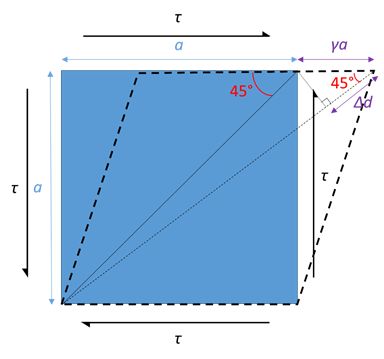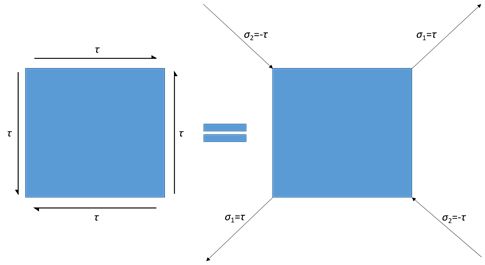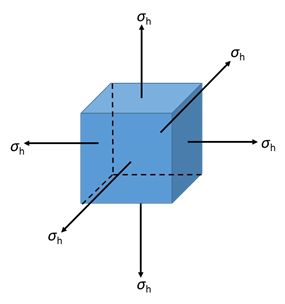Relation between Young's modulus and shear modulus

Consider a stress state above acting on a cube of length \( a \). Assume the shear strain \( \gamma \) is small such that the angle between the diagonal and length is approximately the same, i.e. 45°, before and after shearing.
Strain on the diagonal is
\[ \frac{{{\rm{\Delta }}d}}{{\sqrt 2 a}} = \frac{{\gamma a\;{\rm{cos}}45^\circ }}{{\sqrt 2 a}} = \frac{\gamma }{2} \]
From the definition of shear modulus,
\[ G = \frac{\tau }{\gamma } \]
Strain on the diagonal therefore is \( \frac{\tau }{{2G}} \).
Now consider a set of stress state equivalent to the above case.

By the principle of superposition of two stress pairs, strain on the diagonal is
\[ \frac{{{\sigma _1}}}{E} - \nu \frac{{{\sigma _2}}}{E} = \frac{\tau }{E} - \nu \frac{{ - \tau }}{E} = \frac{\tau }{E}\left( {1 + \nu } \right) \]
where \( E \) is Young’s modulus and \( \nu \) is Poisson’s ratio.
Equating the diagonal strain in two cases gives the relation between Young’s modulus E and shear modulus G:
\[ \frac{\tau }{{2G}} = \frac{\tau }{E}\left( {1 + \nu } \right) \]
\[ E = 2G\left( {1 + \nu } \right) \]
We obtained the relation between Young’s modulus \( E \) and shear modulus \( G \).
We can also relate the bulk modulus \( K \) to Young’s modulus \( E \). Consider a hydrostatic stress state acting on an isotropic cube shown below.

By the principle of superposition, the linear strain in each orthogonal direction is
\[ {\varepsilon_x} = {\varepsilon_y} = {\varepsilon_z} = \frac{{{\sigma _h}}}{E} - \nu \frac{{{\sigma _h}}}{E} - \nu \frac{{{\sigma _h}}}{E} = \frac{{{\sigma _h}}}{E}\left( {1 - 2\nu } \right) \]
The volumetric strain \( \Delta \) is
\[ \Delta = { \varepsilon_x} + {\varepsilon_y} + {\varepsilon_z}= 3\frac{{{\sigma _h}}}{E}\left( {1 - 2\nu } \right) \]
The proof of the first line can be found in here.
From the definition of bulk modulus,
\[ K = \frac{{{\sigma _h}}}{{\rm{\Delta }}} \]
And equating the volumetric strain \( \Delta \), gives the relation between Young’s modulus E and bulk modulus K:
\[ \frac{{{\sigma _h}}}{K} = 3\frac{{{\sigma _h}}}{E}\left( {1 - 2\nu } \right) \]
\[ E = 3K\left( {1 - 2\nu } \right) \]
Equating the two expressions for Young’s modulus, \( E \) yields a relationship between \( G \) and \( K \),
\[ 2G\left( {1 + \nu } \right) = 3K\left( {1 - 2\nu } \right) \]
Interestingly, for an isotropic material, if two of the four elastic constants, \( E \), \( G \), \( K \), \( \nu\) are known, the others can be calculated.

